Gateway P-7808u: to Quad or Not to Quad?
by Jarred Walton on April 13, 2009 3:00 AM EST- Posted in
- Laptops
Gaming Performance
We've chosen to focus on "reasonable" settings for the games below. That means we run Assassin's Creed and Company of Heroes in DX9 mode at maximum detail setting - DX10 reduces performance by quite a bit in AC and by a much larger amount in CoH. We run Crysis at Medium settings (for reference, High detail drops performance almost in half: 20.7 FPS for the P-7808u at 1680x1050). The remaining games are at maximum detail settings, but without any anti-aliasing.
Again, we chose to focus on 1680x1050 as a baseline performance comparison, and we will do so with other laptops going forward. If necessary, we will use an external LCD to run at that resolution - which we did with the P-7808u. Besides 1680x1050, we will also include results at the native LCD resolution, and one other resolution. In this case, we include results at 1440x900, 1680x1050, and 1920x1080. Ideally, you would want to run any laptop at the native LCD resolution, but depending on the game and your hardware that may not be practical. The following charts are color-coded for ease of reference: green is for 1680x1050, red for the native resolution of 1440x900, and gold for results at 1080p. For Mirror's Edge, we also provide results with PhysX enabled, shown in black/purple.
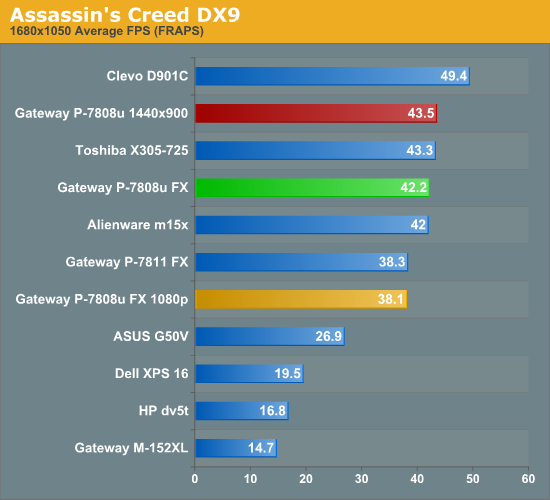
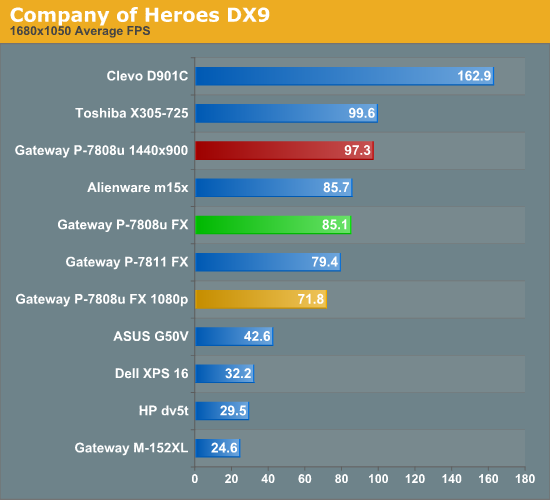
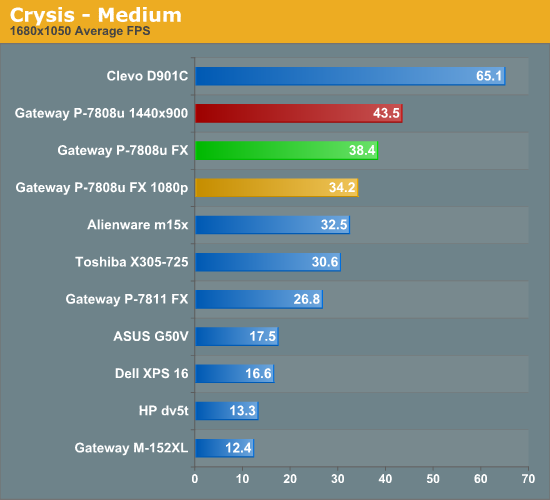

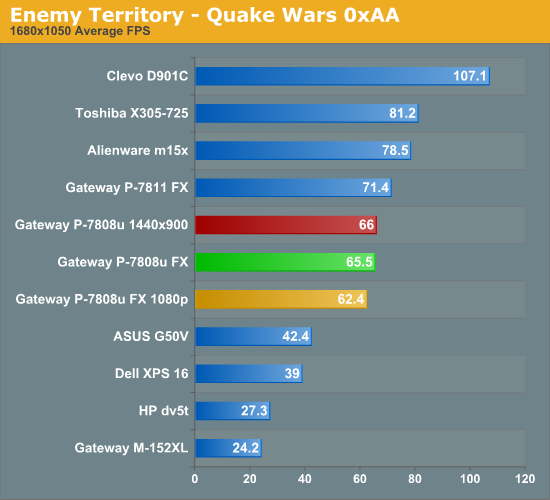
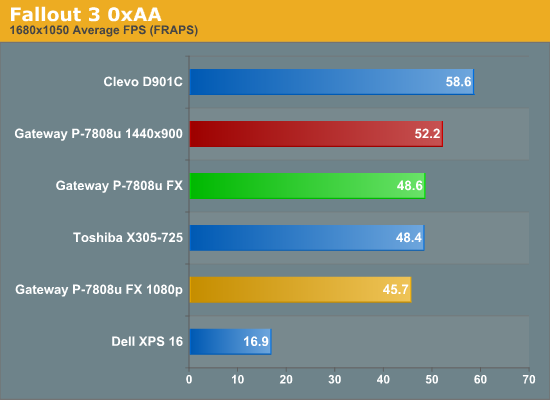
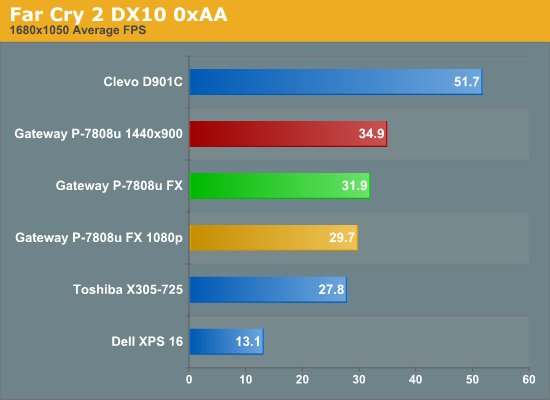
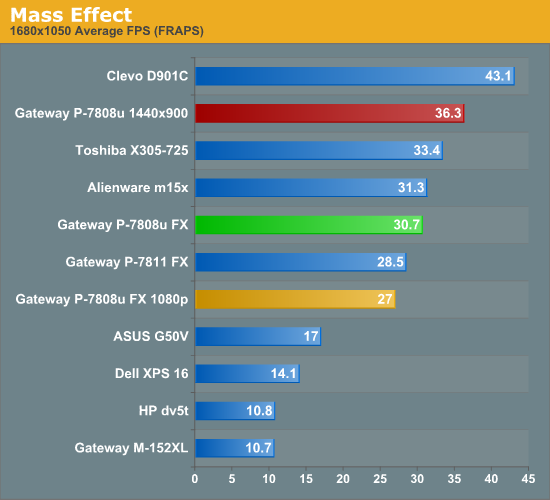
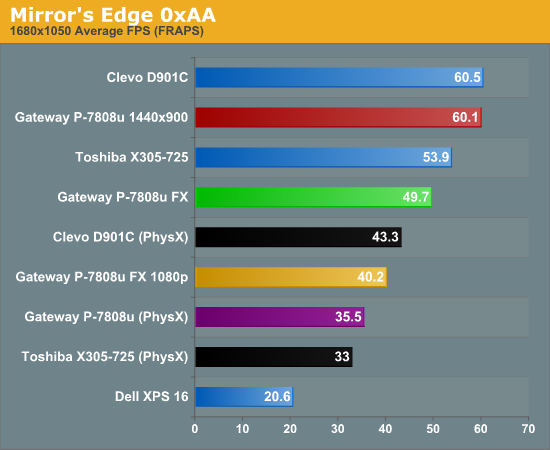
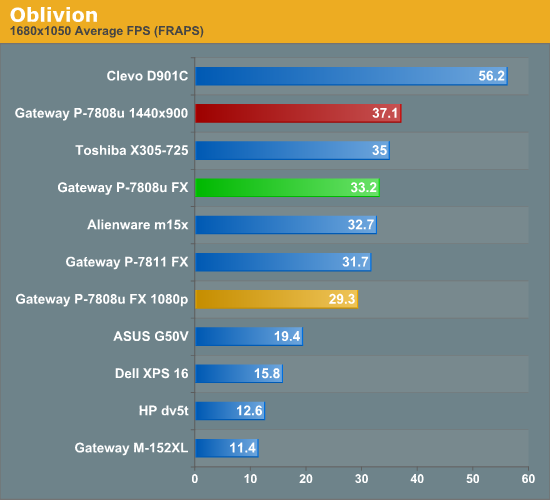
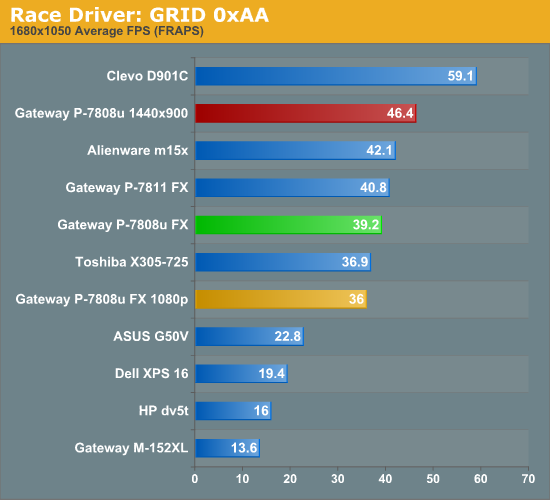
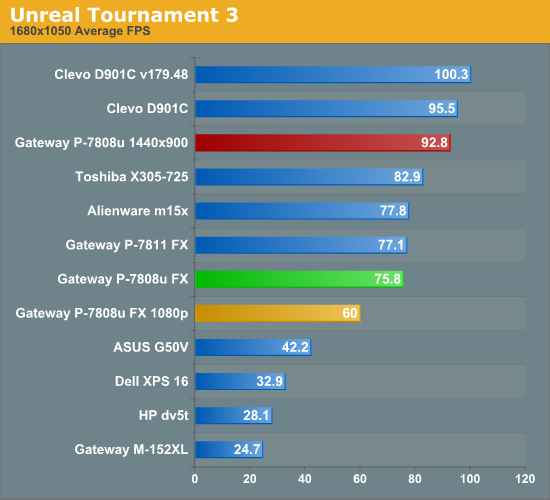
Overall performance in games is very good for a single GPU solution, with only the Toshiba X305-Q725 and the Clevo D901C consistently beating the P-7808u. However, updated drivers have clearly influenced performance in many of the titles; otherwise we would expect the Alienware m15x (8800M GTX) to consistently surpass the P-7808u. There are also a few instances where the older P-7811 is faster than the P-7808u, which we can safely chalk up to the faster 2.26GHz clock speed of the P8400 being more beneficial than the extra cores on the 2.0GHz Q9000. Beyond that, it's a bit difficult to determine how those two laptops actually compare, because of the difference in drivers. Because of the driver changes, we will most likely remove many of the old results in our next laptop review.
In our "equivalent settings" comparison, the P-7808u prices right where you would expect given its use of the GeForce 9800M GT. The 1GB of memory may help in a few games, but very few titles will benefit when running at the native LCD resolution. Focusing just on the results at 1440x900, the P-7808u shows the benefits of running a lower resolution LCD. All of the titles we tested provide very acceptable frame rates at the native LCD resolution, with the only exceptions being Crysis and Far Cry 2. The scores of 43.5 FPS and 34.9 FPS, respectively, are lower than some users would like, but both games remain playable. Those are two of the most demanding titles currently on the market, and they always seem capable of utilizing every ounce of GPU power you can throw at them. We would recommend dropping the detail levels in Far Cry 2 from "Very High" down to "High" or even "Medium" - just as we recommend with Crysis.










16 Comments
View All Comments
andrezunido - Monday, April 13, 2009 - link
Battery/Technology isn't there yet for "affordable" pc gaming on the move. Is it possible that these lower quality screens have substancial power savings when compared to screens like the Dell's XPS 16, or are they just to save on the moneys?It's nice to see the Apple laptops in the battery charts but since these are almost "consoles" (OS and hardware fine tunned for each other - I think Apple compiles the OS with special optimizations for its hand picked hardware), can they really be compared?
crimson117 - Monday, April 13, 2009 - link
Sure they can be compared... hardware manufacturers are allowed to work with MS for driver and OS optimization to make their parts work well with Windows, if they want to.andrezunido - Monday, April 13, 2009 - link
...they should have to! Buggy drivers are responsible for lots of power leaks in idle hardware (low power consumption modes in some drivers are non existent). One of the main reasons for this lack of optimization is the big market for PC's and competition between hardware manufacturers to get the hardware out without proper testing, or drivers that don't support proper power saving optimizations. Of course some of this can be blamed on the "generic" nature of the OS (running on various permutations of hardware), making the testing of hardware/software difficult.The Mac OS has the drivers for its limited hardware configurations partially written by the OS maker allowing the fine-tune of the OS for each computer hardware installation.
Like Anand said in a article, its a model/year thing just like a car. The optimization and integration of hardware and software is a well thought thing in a Mac.
In a generic PC the only way that i know of accomplishing this battery efficiency is by building your own Linux installation (i.e. using Gentoo) and tinker with the kernel, drivers and settings to achieve a power efficient installation (see: http://www.lesswatts.org/)">http://www.lesswatts.org/).
Wrapping it up: It can be compared, but... one has to be mindful of what is what.
andrezunido - Monday, April 13, 2009 - link
Sorry for the bad link, if anyone is interested in getting a bit more power efficient on Linux, http://www.lesswatts.org/">http://www.lesswatts.org/ has some nice software and information.Anyway, the P-7808u seems like a very capable machine for its price. Too bad about the screen quality, being the first thing I consider on a Laptop (Second is Battery), I find it too bad that it was "downgraded" when everything else seemed to be bumped up (even the price unfortunately).
I guess the battery would have to be a expensive monster to feed this kind of performance machine with a decent autonomy. But the screen would have added a lot a value with "potentially" less investment from the manufacturer.
djc208 - Monday, April 13, 2009 - link
I had figured one of these would be top contender for my next laptop but I'm not impressed with this "update". The worst part is that there really isn't a lot of competition for this notebook, even at smaller chassis sizes.I'll just have to hope Gateway or some other company will fill this niche properly by the time I'm ready to buy later this summer.
Thanks for the honest review, hopefully someone at Gateway is listening.
djc208 - Monday, April 13, 2009 - link
I had figured one of these would be top contender for my next laptop but I'm not impressed with this "update". The worst part is that there really isn't a lot of competition for this notebook, even at smaller chassis sizes.I'll just have to hope Gateway or some other company will fill this niche properly by the time I'm ready to buy later this summer.
Thanks for the honest review, hopefully someone at Gateway is listening.